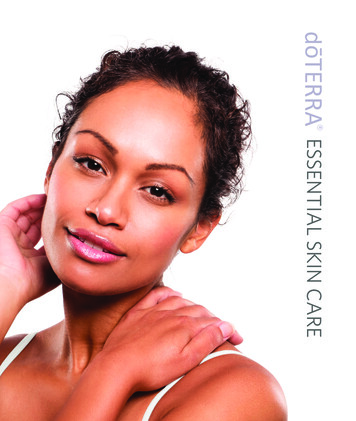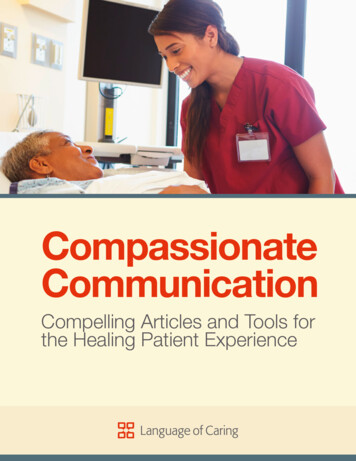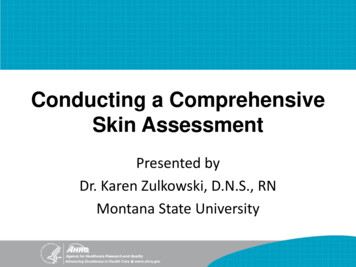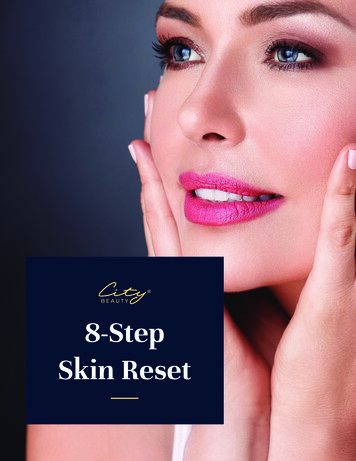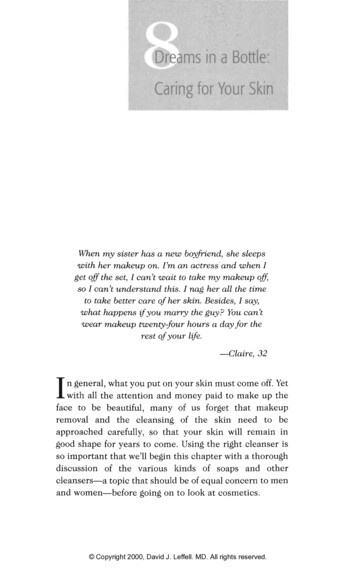
Transcription
Caring for Your SkinWhen my sister has a new boyfriend, she sleepswith her makeup on. I'm an actress"and when Iget off the set, I can't wait to take my makeup off,so I can't understand this. I nag her all the timeto take better care of her skin. Besides, I say,what happens ifyou marry the guy? You can'twear makeup twenty-four hours a day for therest ofyour life.-Claire, 32In general, what you put on your skin must come off. Yetwith all the attention and money paid to make up theface to be beautiful, many of us forget that makeupremoval and the cleansing of the skin need to beapproached carefully, so that your skin will remain ingood shape for years to come. Using the right cleanser isso important that we'll begin this chapter with a thoroughdiscussion of the various kinds of soaps and othercleansers-a topic that should be of equal concern to menand women-before going on to look at cosmetics. Copyright 2000, David J. Leffell. MD. All rights reserved.
76Radiance KEEPING THE SKIN CLEANEvery day the skin is bombarded with dirt and dust particles, and if youwear makeup, then you have to add grease to the list. Most makeups arevery greasy and cannot be removed with water alone.You can take your pick from soaps of all kinds (including deodorantsoaps, medicated soaps, or soapless soaps), washing creams or lotions, andcleansers that come in cream or lotion form. And that's just the beginning.Toners, astringents, and what are called clarifying lotions are also available, depending on how much time and money you wish to invest in skincare.Soaps work to remove dirt because of chemicals called surfactants andemulsifiers. These chemicals are composed of molecules that can attachto both water and grease and thereby dissolve grease and oils from theskin.If you are in a pinch, any soap will do. Whenever you have a choice,however, you'll want to use soaps sparingly and ideally select a nonsoapcleanser. The same qualities in regular soap that help lift off external oils andgrease will also dissolve away the skin's natural fats or lipids, which keep theskin's own moisture locked in. The key principles to remember are: Too much washing leads to dry skin. Too much soap leads to dry skin.OF AIRPLANES, AIRPORTS, AND SITTING ON THE TARMACAs any seasoned traveler knows, the air in airplanes is brutal on the skin. It is very dryand all the sloughed skin cells contribute greatly to the dust in the closed environment.Mode of travel aside, travel in general can wreak havoc on your body. Here are someskin tips for travel:1. Drink plenty of water.2. Do not spray water on your face-it will only evaporate in the dry environment of theairplane leading to drier skin.3. Use a very light moisturizing cream.4. Don't use hotel soaps-pack your favorite nonsoap cleanser.5. Travel with your own shampoo.6. Try to get some rest. Copyright 2000, David J. Leffell. MD. All rights reserved.
Dreams in a Bottle: Caring for Your Skin77Probably the best approach to cleaning your face is to wash once a dayand rinse once a day:1. Wash your face with tap water and a nonsoap cleanser, such as Neutrogena Extra Gentle Cleanser, Aquanil, or Cetaphil once a day.2. Rinse gently with tap water (no cleanser), once a day.3. Always pat dry with a soft towel-do not rub.SQUEAKY CLEAR ABOUT SOAPSRegular soaps, also known as toilet soaps, are made from animal fats,vegetable oils, or olive oils. Other oils, such as coconut or palm kerneloil, may be added to promote lathering. Toilet soaps are inexpensive andcan clean off dirt, dust, grease, and most cosmetics. Because they arealkaline by nature, however, they often irritate the skin. Also, whencombined with "hard" water, soaps can leave behind a filmy residue onthe skin.Superfatted soaps are toilet soaps to which a moisturizer has beenadded. These contain 5 to 15 percent fat, compared with 2 percent in mostsoaps. Some people find these soaps less irritating than ordinary toiletsoaps, while others complain they leave a greasy residue behind.Soapless soaps are less paradoxical than they may sound. Simply put,they substitute fatty acids, petroleum products, or other substances for theingredients found in regular soaps. They tend to irritate the skin less frequently than ordinary soaps.WASHING CREAMS AND LOTIONSWashing or washable creams or lotions are not much different fromplain old bar soap except in price and packaging. The major difference isthat a moisturizer is usually added to a soap or detergent base. The lotionsare just like the creams, with more water added. These products are verypopular now, especially for shower use. I have not seen many problemsfrom the use of these cleansers. Copyright 2000, David J. Leffell. MD. All rights reserved.
78RadianceCLEANSERSCleansers come in creams and lotions. Many of them are soap-free andtherefore appropriate for those people who have allergic reactions to mostsoaps. Cleansers contain water and a cleansing agent, such as cetyl alcohol. The cleanser is applied to the skin and usually rubbed in until it beginsto foam; it's then wiped away with a soft cloth rather than washed off withwater, and a thin layer of moisturizer is left on the skin.If you use heavy makeup, it is a good idea to use a second, lightercleanser to make sure the skin is clean before leaving a layer of moisturizerbehind. If makeup is left on the skin, it can clog pores and cause pimples.Abrasive or exfoliating cleansers are also available. These contain granules intended literally to abrade your skin, sloughing off the dead cells.These cleansers may contain up to 25 percent pumice, a nice word forground volcanic rock. Needless to say, such aggressive cleansing is notideal. If you need a jackhammer to remove makeup residue, you shouldchange makeup products.Most people with normal skin find that exfoliating cleansers dry andirritate the skin, rather than leaving it smooth and glowing. Do not usethese products if you have active acne since the pumice will only aggravatethe condition.WHAT KIND OF SKIN DO YOU HAVE?The most common comments I hear from patients about their skin are: "My skin is toooily" or "My skin is too dry." Here's how to figure out where you are on the spectrum:Normal skin has small pores, is smooth to the touch, and is neither dry nor oily.Dry and/or sensitive skin possesses little natural oil and small pores. It becomesdehydrated, dulls easily, and is prone to lines and wrinkles.Oily skin is prone to excessive oil secretion and is generally shiny. Pores are large andopen. The skin is coarse and subject to blackheads.Combination skin has both oily patches, usually on the central forehead, nose, and chin (theso-called Tlone) and dry patches, usually occuring on the cheeks, jawline, and outer portionof the forehead. Copyright 2000, David J. Leffell. MD. All rights reserved.
D rea m sin aBo ttl e: Car i n g for You r Ski n79If you really feel better using these products, be stingy. No matter howgood you feel about the results of a single usage, you should refrain fromfrequent use. You'll find that the more you use one, the drier your skin willbecome. It may even start to flake and, in some cases, you may begin tonotice broken blood vessels. So, proceed with caution.TONERS, ASTRINGENTS, AND CLARIFYING LOTIONSThis group of skin-care products are often alcohol-based. Toners andastringents remove excess oil from the skin because alcohol dissolves fattychemicals. They are usually scented to cover the medicinal smell of thealcohol. While the coolness they impart may give the impression of tighterpores and better skin tone, this tends to be a passing fancy.An astringent or toner may also include other ingredients. Menthol orcamphor adds to the cooling sensation. Salicylic acid or witch hazel are strongastringents that may even have a light peeling effect on the skin. In general,keep alcohol-containing products away from your skin as much as possible.CLEANSING MASKSIf you wash your face regularly with a good cleansing agent, mostcleansing masks will add little to your cleansing regime. However, if you dohave oily skin, you may want to use an antibacterial cleansing mask nowand then to help minimize the oil on your skin.Some facial masks claim to reduce the redness in the skin and tightenpores. Although there is no solid evidence that this is so, many peoplereport that using a light facial mask helps them feel better about their skin.If you can afford it and find the feeling of a facial mask pleasant, that is agood enough reason to indulge yourself when you have a spare ten or fifteen minutes. Facial masks will not remove large facial pores but may temporarily remove accumulated cells and oils that enlarge the pores andmake them look big.BATHING AND WASHINGContrary to what you might think after riding on a crowded bus or subway or squeezing through a large crowd at the football stadium, we probably wash ourselves too often, sometimes bathing twice daily. Such frequentbathing dries skin, and the problem can be compounded by the use of Copyright 2000, David J. Leffell. MD. All rights reserved.
80Rad ian c eharsh soaps. Remember, dry skin looks older and may even "age" morerapidly.A mild soap should be used to wash areas that perspire a lot, such as theneck area and under the arms, and to wash the genital area. The dirt andgrime accumulated during the day on the rest of the body can be removed,without soap, by cleaning the skin gently with a soft wash cloth or skinmassage gloves and then rinsing with water. Avoiding the frequent use ofsoap will help maintain the proper natural oils on the surface of the skinwhich provides protection in the skin's daily battle with the world. Soaplesssoaps or cleansers may also be substituted for traditional bath soaps. MOIST Is GOOD, DRY IS BADOur skin is cleverly designed to prevent evaporation of moisture fromwithin its topmost layer. Yet when the skin dries out, this protective ability is lost and the integrity of our skin and our comfort suffer. For this reason, proper moisturizing is critical.Moisturizers can't make you younger, but they can keep your skinhydrated. Dry skin is the result of water loss in the stratum corneum-thesurface layer of the epidermis. As the stratum corneum loses moisture,your skin starts to become drier and drier, until it eventually begins toflake. A good moisturizer serves two important functions: it retards moisture loss and helps to draw water back into the stratum corneum.There are two kinds of moisturizers, oil-based and water-based. Moisturizers contain different kinds of oil, and the ratio of water to oil variesfrom product to product. Obviously, which type you choose will depend onyour skin type. If your skin is oily and adulthood has brought you littlerelief from the acne blues, you'll want to use a water-based moisturizer inorder to avoid burdening your pores with more oil. If your skin is dry tonormal, you can go ahead and choose an oil-based moisturizer.People with so-called combination skin (areas of dry skin and patchesof oily skin) should stick with a water-based product. However, in wintertime, I advise my patients with combination skin to spend a little extratime on skin care and use two moisturizers-a water-based one for general skin care, and an oil-based one for particularly dry patches of skin.Avoid moisturizers that contain alcohol. These can sting and dry the skinas well.Once you get past the basics-oil-based vs. water-based-there arescores of moisturizers to choose from. There are moisturizing creams, Copyright 2000, David J. Leffell. MD. All rights reserved.
Dreams in a Bottle: Caring for Your Skin81lotions, gels . you name it. There are moisturizers that contain a sunscreen. The best advice is to find a product you like-it doesn't have tohave an expensive label-and apply it after showering. Keep a small tubeof special hand cream such as Neutrogena Hand Cream at the readyif you tend to have dry hands and chapped lips, especially during thewinter. COSMETIC OR "COSMACEUTICAL"?No one would doubt that lipstick, blush, foundation and even hair coloring are cosmetics. They are removable or they wear off, and they don'tchange the structure or function of your skin.However, the issue gets a bit trickier when talking about those creamsthat include vitamin C, enzyme CoQ 10, or any other agents that areintended to function as antioxidants. This category of compounds-onwhose behalf claims are made about decreasing fine lines and wrinkles andeven, perhaps, preventing skin cancer-is increasingly being called "cosmaceutical." In time we will probably identify a class of compounds thatdo live in the no-man's-land between true cosmetic and true drug. For now,be suspect of claims that seem unreasonable. COSMETICSMost women know what cosmetics they like, tolerate, and prefer to buy.Every consumer has her own preferred product, but the search for new lipsticks, lip gloss, eye makeup, etc., nonetheless continues. Open any medicine cabinet and you will see proof of this. The cosmetics industry ismarketing-rich: just like the cereal industry it knows that people will likelybuy many different brands of the same product. What drives this is thehuman desire to get the newest and latest, and there is nothing wrong withthat. Just be sure to follow some simple rules: When it comes to makeup, keep it simple. Don't overspend. Don'toverapply. Use only non-comedogenic (non-acne causing) products that arealso hypoallergenic. Usually, the label clearly states these features.Makeup that is very oily can clog pores and precipitate acne. Chemicals in non-hypoallergenic makeup can lead to rashes. Copyright 2000, David J. Leffell. MD. All rights reserved.
82Rad ian c e Once you've found a product or product line you like, stick with it. Ifyou bounce around from one to the other, you increase the risk thatyou will happen upon a product that your skin doesn't like. In searching for the ideal product, go with a major brand. These manufacturers have enough money to thoroughly research their productsbefore bringing them to market. (Regarding buying animal-testedproducts, this is purely a matter between you and your conscience.There is nothing intrinsically better, from the scientific viewpoint,about products that have not been animal-tested.) If you are buying a product from your doctor's office, be sure he orshe knows what is in it. If you are buying herbal or "natural" products, be sure that the ingredients are listed. If you develop a rash, it will be helpful to know whatit might be due to.There are usually three types of ingredients to be concerned with whenchoosing a cosmetic. Active ingredients actually do something for yourskin, such as moisturize it or protect it from the sun. Inactive ingredientsare there to thicken, stiffen, or preserve the product-in essence, they arenecessary to make the cosmetic "work." Finally there are exotic ingredients that may be hyped but are not yet proven to be of value.WHAT DOES HYPOAllERGENIC MEAN?Strictly speaking, hypoallergenic means that the cream or lotion will not cause an allergic reaction of the skin, akin to poison ivy or some other reaction that your immune system causes. These days, however, this term is taken by the public to mean a broad rangeof things. The labels on cosmetic products contain many of the following words, whichall intend to imply hypoallergenicity in the broad general ngAllergy-free Copyright 2000, David J. Leffell. MD. All rights reserved.
Dr e am sin aBo tt Ie: Car i n g for Yo u r Ski n83WHAT ABOUT ALLERGIES?When you have a true allergic reaction to ingredients in the cosmeticsyou use, some patches of scaling and redness may develop. Fragrances andpreservatives within cosmetics are among the most common causes ofallergic reaction in skin. In one study, two-thirds of people with facial rashhad some form of allergic contact dermatitis-in other words, their rashwas due to something they were putting on their face. If you do develop arash and believe a cosmetic or fragrance is to blame, see your dermatologist. An elimination program may be followed by skin-patch testing withspecific compounds; this will help you avoid purchasing products that contain the specific offending agent.SKIN CARE OR SKIN HEALTH?Cosmetics are used to make our skin feel better and look better. Pharmaceuticals and even certain cosmaceuticals are used in an attempt toactually change the biology of our skin. Cosmaceuticals don't require FDAapproval; medicated creams do. The main things to watch for with any cosmetic are irritation, acne, and allergic reaction. Not all sensitivities areallergic, but a red, rough, stinging rash or a pimply outbreak should beenough to get you to switch products.Here are suggestions to get the most bang for your makeup buck:1. Use a moisturizer that has an SPF of 15 or higher. This way, whenyou apply your facial moisturizer daily you'll at least know you havethat baseline sun protection. After all, sun protection is the mostimportant thing you can do to keep your skin looking young.2. Always use lip balms with an SPF of 15 or higher.3. Clean makeup brushes regularly with a gentle shampoo, such as ababy shampoo.4. To get a subtle but noticeable glow on your cheeks use about a peppercorn of Vaseline on your cheekbones.5. Be alert to eyelid rashes. These can be due to an allergy to your nailpolish, which comes in contact with your eyelids when you rub your Copyright 2000, David J. Leffell. MD. All rights reserved.
84Rad ian c eeyes. The thin skin of the eyelids is especially sensitive to allergicreaction.6. As often as possible try to let your hair dry naturally. If you must usea blow-dryer, wait until your hair is just damp, virtually dry. MAKEUPCONCEALERSWhen it comes to face makeup foundations are the heavy hitters. Theyare applied to the entire face and, as the name suggests, provide a basecoat of facial "paint" that helps to hide blemishes, scars, fine lines, andsmall irregularities. Think of foundation as a housepainter would think ofprimer.If you don't use that much makeup, but do want to hide that telltaleblemish or slight skin discoloration, concealers offer a choice. They alsohelp hide dark circles and shadows. Because they are heavier and creamierthan foundation makeups, concealers should be used sparingly and only onspecific areas of the face. Concealers are usually oil-based moisturizers withadded pigments. If you are prone to acne, it's possible to find oil-free, medicated concealers that will help clear your acne while covering it up.COVER STICKS. Some cosmetic users find cover sticks an easier and more convenientform of concealer that can camouflage a multitude of minor sins. It shouldbe noted, however, that cover sticks do contain a lot of wax. This gives themakeup body and thickness, but it can also irritate the skin and causeacne-prone skin to break out.POWDERSPowders are used to absorb oil and reduce shininess, but in the processthey can also clog pores. The popularity of face powder is probably due tothe widely held belief that a shiny nose or cheek is an uglier nose or cheek.The active ingredients in powder cosmetics are pigments and powders.Iron oxides are a common pigment. Other ingredients include talc, clay,starch, and agents that hold the powder together. Copyright 2000, David J. Leffell. MD. All rights reserved.
D rea m sin aBo t tI e: Car i n g for You r Ski n85For very oily, acne-prone skin, a powder alone should be used; it willcause less pore clogging than a base or pancake with a powder applied on top.To wash off powders and cream-based makeup, you might want to usetwo cleansers to be sure that you have removed every trace of these poreclogging cosmetics.BLUSHBlushes can be oil-based or oil-free. They are used to add contour andcolor to your skin. Find one brand you like and stick to it.EYE SHADOW AND EYE PENCILThese are composed of pigments mixed in oil-wax bases. Cream eyemakeups should be applied with a soft brush or sponge and washed offthoroughly with a gentle cleanser.The skin of the eyelid and surrounding eye region is perhaps the mostsensitive of your body's skin. It is extremely thin and is thus easily irritated. Therefore, treat it with care and kindness. Watch for makeup thatcontains mica, which may irritate the eye. If your eye makeup causes evenminor irritation, try another product.LIQUID LINER AND MASCARAInorganic pigments are the basic ingredient in liquid liners; film-forming or plasticizing chemicals, acrylic copolymers and acrylates, are thenadded. Such chemicals help the liners adhere and provide sheen. Don'tapply these products under the rim of the eyelid or too close to the cornersof the eyes, or you may experience itching and irritation.MASCARAApplied to the eyelashes to add the illusion of thickness and luster tothin or short lashes, mascara is formed by adding pigment to a moisturizing base. Conditioning mascaras, which contain water-based moisturizers,are also available. Waterproof mascaras contain oil-based moisturizers towhich shellacs and other hardeners may be added. Although many mascara manufacturers tout special mascara removal aids, you can easilyremove mascaras with a gentle moisturizer. Copyright 2000, David J. Leffell. MD. All rights reserved.
86Rad ian c eLIPSTICK AND LIP GLOSSLipsticks can be the stuff of romance and seduction. They are basicallywax, oil, and pigment mixed together.Many of the new brands boast that they protect against chapped lipsand the sun's rays. Select lipstick with sunscreen that does not containPABA since some people are allergic to this ingredient. In the absence ofPABA, the dye in lipstick should be suspected if you develop lip irritation.Many natural lip glosses are available. These do not color the lips, butthey do keep them moist and shiny. Plain cocoa butter is a fine lip balm.Eye sticks, used to moisturize the particularly sensitive skin under theeyes, also work well to keep lips moist and healthy.If you have an active herpes lesion, don't share your lipstick or lip glosswith someone else. By the same token, don't borrow lip products fromsomeone with a fever blister. COSMACEUTICALSThe many claims made for all sorts of over-the-counter products arehard to sort out.' As an experiment, pick up a copy of your favorite women'smagazine (or even men's magazine) and look at the ads that are designedto catch your attention. In general, those for skin creams convey theimpression that in some way the product will stall or reverse the agingprocess in your skin or make you look younger. The wording is carefullyphrased-close enough to keep the Feds (the Food and Drug Administration, actually) parked outside on lookout, but not so outrageous that theybarge in with a battering ram. It's good that companies know their claimsare being very carefully watched, since it helps keep them honest. CELLULITEA wide range of products claim to reduce cellulite, or the puckeredappearance of fat on the thighs. I know of no cream, however, that has aneffective chemical that penetrates the skin and dissolves the fibrous tethers that cause cellulite.Cellasene is an aggressively marketed herbal remedy for cellulite thatthe manufacturer claims increases circulation. It contains ginkgo, sweetclover, bladder wrack, grape seed extract, fish oil, and lecithin, among Copyright 2000, David J. Leffell. MD. All rights reserved.
Dreams in a Bottle: Caring for Your Skin87other ingredients. Keep in mind that each capsule contains 240 milligramsof iodine, so people with thyroid problems can be adversely affected bychronic use of Cellasene. Also, the sweet clover and ginkgo might increasethe risk of bleeding for patients on aspirin or warfarin.Cellasene costs about 8300 for a full course of treatment. As far as Iknow no peer-reviewed study has been published confirming that use ofthis supplement reduces cellulite or thigh girth. Although the risks are low,pregnant or nursing women should of course not use it.Endodermologie is not a pill or cream but a treatment that involvespassing a probe over cellulite-ridden skin. SilkLight is another one of thesemassage therapies. Although the FDA permits manufacturers of thesedevices to say that they can help make the skin look better, this is certainlynot the same as saying that in proper trials it is proven to eliminate cellulite.CELLULITE CREAMSMost cellulite creams, sold by reputable companies, include thewords firming and body in the name of the product. These are pretty safewords to use, since they don't specifically say what they are firming (mostmoisturizers can be said to be firming the epidermis). People who usethese products say that their skin feels smoother, if they notice any effectat all.STRETCH MARKSStretch marks that develop after pregnancy can be very frustrating. Ifthey are noticeable because of redness, laser treatment of the rednessmay help improve their appearance. Some dermatologists believe thateven Retin-A can help build up the collagen in the area, just as it does insun-damaged skin, and thereby improve the appearance. Others havetried resurfacing lasers, like the kind used to remove wrinkles. Mostrecently, a new cream is being marketed as a cosmaceutical to improve orremove stretch marks. It has not been proven to work in any clinical trials although the manufacturer is now conducting a survey to see if itworks (kind of backwards, in my opinion).Stretch marks result from thinning of the epidermis and loss of collagen.The only way to improve the problem is to actually replace what is missing. Copyright 2000, David J. Leffell. MD. All rights reserved.
88Rad ian c e VITAMIN CThe rationale for including vitamin C, an antioxidant, in skin creams isthat it may remove the free radicals that cells produce. These free radicalsare associated with skin cancer and premature aging of the skin such as thatdue to sun exposure. Many cosmaceuticals advertise that they contain vitamin C, but most forms of vitamin C are unstable when exposed to the air.Cellex C is a product that claims greater stability and even penetration intothe skin.While topical vitamin C may help lighten solar lentigos and melasma,it has not been shown to help rebuild collagen in the skin. There has beensome scientific evidence that the correct form of topical vitamin C provides additional protection against the harmful effects of the sun.Until it can be reliably shown that vitamin C penetrates through theepidermis, there is no reason to believe that it will have an effect on collagen production, and thus on wrinkles. RETIN-AThe news regarding salvaging damaged skin is promising. Skin that hasbeen regularly overexposed to the sun will never look as good as skin thathas been consistently protected from the sun and other damaging environmental elements. I can safely say that some improvement of skin quality is possible through treatment with Retin-A.The improvement Retin-A helps to make in sun-damaged skin beginsreasonably quickly, within three months. Tretinoin, the active ingredientin Retin-A, and its cousins Renova and Retin-A Micro, is approved by theFDA as a safe and effective means to improve the appearance of sundamaged skin. Many people have tried Retin-A but complain that it doesn'thelp improve the fine lines and wrinkles. Upon further investigation, it isclear that these people have usually discontinued use of the medicationbecause of dryness or irritation. See recommendations for a home facialprogram on page 74 on how to step into the use of Retin-A slowly and carefully. When using Retin-A it is also important to keep your skin well moisturized (to minimize dryness) and use sunscreen regularly. Copyright 2000, David J. Leffell. MD. All rights reserved.
D rea m sin aBo ttl e: Car i n g for You r Ski n89 WHAT ABOUT NATURAL INGREDIENTS?Guess what? Retin-A is a form of vitamin A, which comes fromcarotene, which is present in carrots. Carrots come from the ground andare of course natural. So it goes with so many compounds in medicine.There are many "natural" agents that can be found in health care products.Here are just a few of the natural ingredients you'll find in some of themost popular skin care products. Look for them when you read the labelsbefore choosing a product. Alpha-hydroxy acids (AlIAs), an ingredient in a wide range of moisturizers and anti-aging creams, are as natural as they can be. Glycolic acid is derived from sugar cane. Lactic acid comes from milk,malic from apples, and tartaric from grapes. Citric is an AHA that hasbeen around for a while. AHAs are thought to soften lines and wrinkles, improve skin tone, help erase age spots or sun spots, and evencontrol acne. Clay is used as a base in many facial masks. It is rich in minerals andis known as nature's detoxifier. Clay masks may help improve circulation temporarily, cleanse the surface of the skin, and revitalize it.Clay is not considered a cause of allergic reactions in the skin. Oat is a natural grain that is rich in vitamins and minerals. Thiscereal protein, with an excellent balance of amino acids, is used inmany cosmetic products. It is known to soothe sensitive skin andrelieve itching and other irritations. It is also an effective moisturizersince it is a humectant, which means it promotes the retention ofmoisture-just what your skin needs. Plant oils were used to make the first cosmetics and are now back invogue. You'll find them in many of today's most popular moisturizers.Some of the most popular plant oils used in cosmetics are almond,apricot, avocado, flaxseed, hazelnut, olive, sesame, and wheat germoils. Some of these oils are comedogenic (see Appendix 4, SelectiveGuide to Skin Care Products). Aloe 'Vera is a useful, versatile addition to the skin care world. Thespearlike, fleshy leaves of this tropical plant contain a clear and Copyright 2000, David J. Le
of oily skin) should stickwith a water-basedproduct. However, in winter time, I advise my patients with combination skin to spend a little extra time on skin care and use two moisturizers-awater-basedone for gen eral skin care, and an oil-basedone for particularly dry

